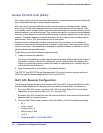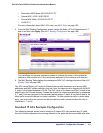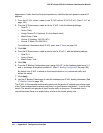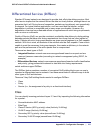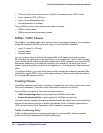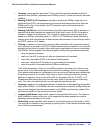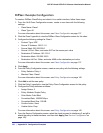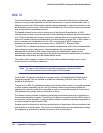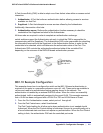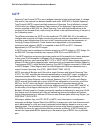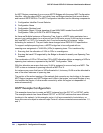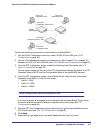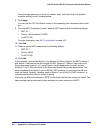
260 | Appendix B: Configuration Examples
GS716Tv2 and GS724Tv3 Software Administration Manual
802.1X
Local Area Networks (LANs) are often deployed in environments that permit unauthorized
devices to be physically attached to the LAN infrastructure, or permit unauthorized users to
attempt to access the LAN through equipment already attached. In such environments, it may
be desirable to restrict access to the services offered by the LAN to those users and devices
that are permitted to use those services.
Port-based network access control makes use of the physical characteristics of LAN
infrastructures in order to provide a means of authenticating and authorizing devices attached
to a LAN port that has point-to-point connection characteristics and of preventing access to
that port in cases in which the authentication and authorization process fails. In this context, a
port is a single point of attachment to the LAN, such as ports of MAC bridges and
associations between stations or access points in IEEE 802.11 Wireless LANs.
The IEEE 802.11 standard describes an architectural framework within which authentication
and consequent actions take place. It also establishes the requirements for a protocol
between the authenticator (the system that passes an authentication request to the
authentication server) and the supplicant (the system that requests authentication), as well as
between the authenticator and the authentication server.
The switch switch supports a guest VLAN, which allows unauthenticated users to have
limited access to the network resources.
Note: You can use QoS features to provide rate limiting on the guest VLAN
to limit the network resources the guest VLAN provides.
Another 802.1X feature is the ability to configure a port to Enable/Disable EAPoL packet
forwarding support.You can disable or enable the forwarding of EAPoL when 802.1X is
disabled on the device.
The ports of an 802.1X authenticator switch provide the means in which it can offer services
to other systems reachable via the LAN. Port-based network access control allows the
operation of a switch’s ports to be controlled in order to ensure that access to its services is
only permitted by systems that are authorized to do so.
Port access control provides a means of preventing unauthorized access by supplicants to
the services offered by a system. Control over the access to a switch and the LAN to which it
is connected can be desirable in order to restrict access to publicly accessible bridge ports or
to restrict access to departmental LANs.
Access control is achieved by enforcing authentication of supplicants that are attached to an
authenticator's controlled ports. The result of the authentication process determines whether
the supplicant is authorized to access services on that controlled port.



